Indigenous Knowledge Systems and Practices (IKSPs), Livelihood Resources and Aspirations of the Matigsalog and Ata Tribes
Abstract
1. Introduction
2. Materials and Methods
2.1. Study Area
2.2. The Matigsalog Tribe
2.3. The Ata Tribe
2.4. Approach of Study
2.5. Focus Groups
2.6. Validation
2.7. Actual Farm Visit
3. Results
3.1. Livelihood and Resources in the Area
3.2. Different Crops Available in Marilog District and Their Uses
3.3. Different Crops Available in Paquibato District and Their Uses
3.4. Seasonality and Farming Strategies of Important Crops
3.5. Perception of Climate Change Events
3.6. Climate Change Impacts on Livelihood and Aspirations for Well-Being
3.7. Climate Change Adaptation Strategies
4. Discussion
4.1. Livelihood Aspirations
4.2. Crop Management and Utilization
4.3. Climate Change Adaptation Strategies
4.4. Towards Sustainable Agriculture Practices
5. Conclusions
Author Contributions
Funding
Informed Consent Statement
Data Availability Statement
Conflicts of Interest
References
- Tengö, M.; Brondizio, E.S.; Elmqvist, T.; Malmer, P.; Spierenburg, M. Connecting diverse knowledge systems for enhanced ecosystem governance: The multiple evidence base approach. Ambio 2014, 43, 579–591. [Google Scholar] [CrossRef]
- Marcogliese, D.J. The impact of climate change on the parasites and infectious diseases of aquatic animals. Rev. Sci. Tech. 2008, 27, 467–484. [Google Scholar] [CrossRef]
- Berkes, F.; Colding, J.; Folke, C. Rediscovery of Traditional Ecological Knowledge as Adaptive Management. Ecol. Appl. 2000, 10, 1251–1262. [Google Scholar] [CrossRef]
- Mendoza, J.C.; de la Cruz-Modino, R.; Dorta, C.; Martín- Sosa, P.; Hernández, J.C. Ecosystem modeling to evaluate the ecological sustainability of small-scale fisheries: A case study from El Hierro, Canary Islands. Ocean. Coast. Manag. 2022, 228, 106297. [Google Scholar] [CrossRef]
- Yazdanpanah, M.; Tajeri Moghadam, M.; Savari, M.; Zobeidi, T.; Sieber, S.; Löhr, K. The Impact of Livelihood Assets on the Food Security of Farmers in Southern Iran during the COVID-19 Pandemic. Int. J. Environ. Res. Public Health 2021, 18, 5310. [Google Scholar] [CrossRef] [PubMed]
- Manik, S.M.N.; Pengilley, G.; Dean, G.; Field, B.; Shabala, S.; Zhou, M. Soil and Crop Management Practices to Minimize the Impact of Waterlogging on Crop Productivity. Front. Plant Sci. 2019, 10, 140. [Google Scholar] [CrossRef]
- Derr, V.; Corona, Y. (Eds.) Latin American Transnational Children and Youth: Experiences of Nature and Place, Culture and Care across the Americas, 1st ed.; Routledge: London, UK, 2020. [Google Scholar]
- Zhong, B.; Wu, S.; Sun, G.; Wu, N. Farmers’ Strategies to Climate Change and Urbanization: Potential of Ecosystem-Based Adaptation in Rural Chengdu, Southwest China. Int. J. Environ. Res. Public Health 2022, 19, 952. [Google Scholar] [CrossRef] [PubMed]
- Hernani, E.V.; Hernani, M.R.; Dulay, D.A. Dancing With the Dreamweavers: A Narrative Discourse of the T’bolis of the Southern Philippines. In Indigenous Research of Land, Self, and Spirit; Throne, R., Ed.; IGI Global: Hershey, PA, USA, 2021; pp. 200–214. [Google Scholar]
- Singh, R.; Sureja, A. Indigenous knowledge and sustainable agricultural resources management under rainfed agro-ecosystem. Indian J. Tradit. Knowl. 2008, 7, 642–654. [Google Scholar]
- Heywood, N.A. Community Planning: Integrating Social and Physical Environments; Wiley-Blackwell: Oxford, UK, 2011. [Google Scholar]
- Martínez-Martí, M.L.; Theirs, C.I.; Pascual, D.; Corradi, G. Character Strengths Predict an Increase in Mental Health and Subjective Well-Being over a One-Month Period during the COVID-19 Pandemic Lockdown. Front. Psychol. 2020, 11, 584567. [Google Scholar] [CrossRef]
- Khan, M.; Yong, L.H.; Han, B.J. Emerging techniques for enhancing the performance of humanitarian logistics. Int. J. Sup. Chain. Mgt 2019, 8, 450. [Google Scholar]
- Akinnifesi, F.K.; Mhango, J.; Sileshi, G.; Chilanga, T. Early growth and survival of three miombo woodland indigenous fruit tree species under fertilizer, manure and dry-season irrigation in southern Malawi. For. Ecol. Manag. 2008, 255, 546–557. [Google Scholar] [CrossRef]
- Nyong, P.A.; Martin, N.T. Enhancing agricultural sustainability and productivity under changing climate conditions through improved agroforestry practices in smallholder farming systems in Sub-Saharan Africa. Afr. J. Agric. Res. 2019, 14, 379–388. [Google Scholar] [CrossRef]
- Lebria, R.T. Age and Sex Distribution in Davao City (2020 Census of Population and Housing); Philippine Statistics Authority (PSA): Quezon City, Philippines, 2020.
- Jorolan, G. Perceived Effects of Education among Female members of the Ata Manabo, Mandaya and Mansaka Communities in the Davao Region. Banwa 2005, 1, 86–132. [Google Scholar]
- Ulindang, F. Lumad Mindanao. 2002. Available online: http://www.ncca.gov.ph/researchlumad.htm (accessed on 2 April 2023).
- Dey, I. Qualitative Data Analysis: A User-Friendly Guide for Social Scientists; Taylor and Francis: London, UK, 2005. [Google Scholar]
- Elo, S.; Kyngäs, H. The qualitative content analysis process. J. Adv. Nurs. 2008, 62, 107–115. [Google Scholar] [CrossRef] [PubMed]
- Robinson, O.C. Sampling in Interview-Based Qualitative Research: A Theoretical and Practical Guide. Qual. Res. Psychol. 2013, 11, 25–41. [Google Scholar] [CrossRef]
- Bonter, D.N.; Cooper, C.B. Data validation in citizen science: A case study from Project FeederWatch. Front. Ecol. Environ. 2012, 10, 305–307. [Google Scholar] [CrossRef]
- Barau, A.A.; Afrad, M.S.I.; Rahman, M.S.; Rahman, M.A. Indigenous peoples’ livelihood practices in south-eastern Bangladesh and the question of sustainability. Sustain. Dev. 2019, 27, 809–816. [Google Scholar] [CrossRef]
- Ajibade, L.T. In search for methodology for the collection and evaluation of farmers’ indigenous environmental knowledge. Indilinga Afr. J. Indig. Knowl. Syst. 2003, 2, 99–105. [Google Scholar] [CrossRef]
- Galang, E.I.N.E.; Vaughter, P. Generational local ecological knowledge on the benefits of an agroforestry landscape in Mindanao, Philippines. Asian J. Agric. Dev. 2020, 17, 90–108. [Google Scholar] [CrossRef]
- Akullo, D.; Kanzikwera, R.; Birungi, P.; Alum, W.; Aliguma, L.; Barwogeza, M. Indigenous knowledge in agriculture: A case study of the challenges in sharing knowledge of past generations in a globalized context in Uganda. In Proceedings of the World Library and Information Congress: 73rd IFLA General Conference and Council, Durban, South Africa, 19–23 August 2007; pp. 19–23. [Google Scholar]
- Bisht, I.S.; Rana, J.C.; Pal Ahlawat, S. The future of smallholder farming in India: Some sustainability considerations. Sustainability 2020, 12, 3751. [Google Scholar] [CrossRef]
- Hobbs, P.R. Paper Presented at International Workshop on Increasing Wheat Yield Potential, CIMMYT, Obregon, Mexico, 20-24 March 2006. Conservation agriculture: What is it and why is it important for future sustainable food production? J. Agric. Sci. 2007, 145, 127–137. [Google Scholar] [CrossRef]
- Sanni, G.B.T.A.; Ezin, V.; Ahanchede., A. Farmers’ knowledge, practices and use of sesame genetic resources in the production systems of Benin: Case study of agro-ecological zone IV. Heliyon 2022, 26, e11870. [Google Scholar] [CrossRef]
- Lohri, C.R.; Diener, S.; Zabaleta, I.; Mertenat, A.; Zurbrügg, C. Treatment technologies for urban solid biowaste to create value products: A review with focus on low- and middle-income settings. Rev. Environ. Sci. Biotechnol. 2017, 16, 81–130. [Google Scholar] [CrossRef]
- Nelson, G.L.M.; Zamora, O.B.; de Guzman, L.E.P.; Tatlonghari, R.V.; Espaldon, M.V.O.; Brillon, J.A. The Indigenous Practices and Climate Change Responses of Ati and Suludnon Farmers in Iloilo, Philippines. J. Environ. Sci. Manag. 2019, 22, 87–98. [Google Scholar] [CrossRef]
- Aydinalp, C.; Cresser, M.S. The effects of global climate change on agriculture. Am.-Eurasian J. Agric. Environ. Sci. 2008, 3, 672–676. [Google Scholar]
- Cardenas, J.C.; Carpenter, J. Risk attitudes and economic well-being in Latin America. J. Dev. Econ. 2013, 103, 52–61. [Google Scholar] [CrossRef]
- Narayanasamy, P. Traditional knowledge of tribals in crop protection. Indian J. Tradit. Knowl. 2006, 5, 64–70. [Google Scholar]
- Tanduyan, R.G. Fertilizer and Pesticide Authority (FPA) Online ISSN: 2815-1674. Published by the FPA Information and Communications Team. 2022. Available online: https://fpa.da.gov.ph/NW/index.php/information-resources/publications/articles/536-60-indigenous-farmers-from-maragusan-receive-training-on-gap-and-bfs (accessed on 5 May 2023).

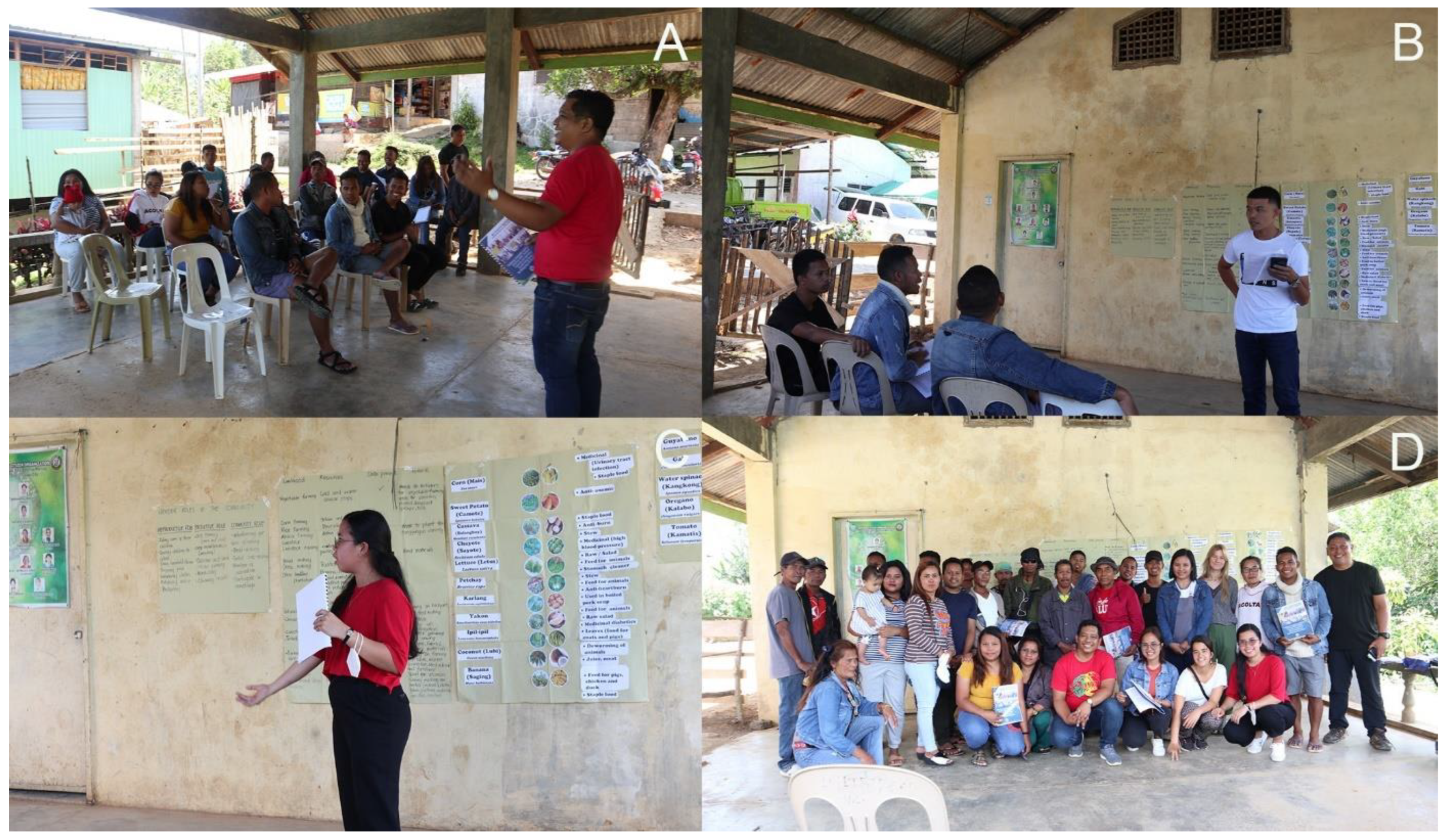
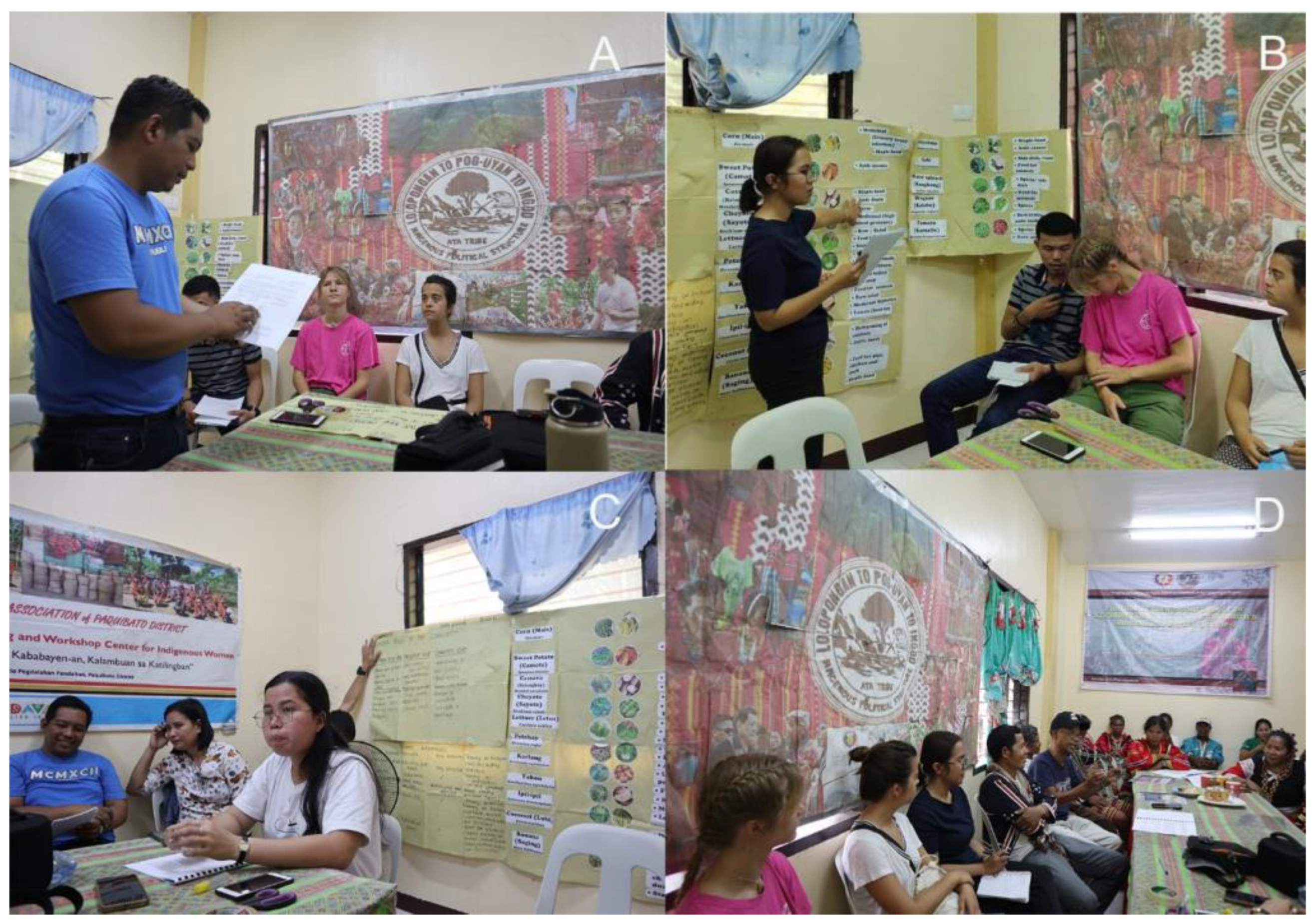
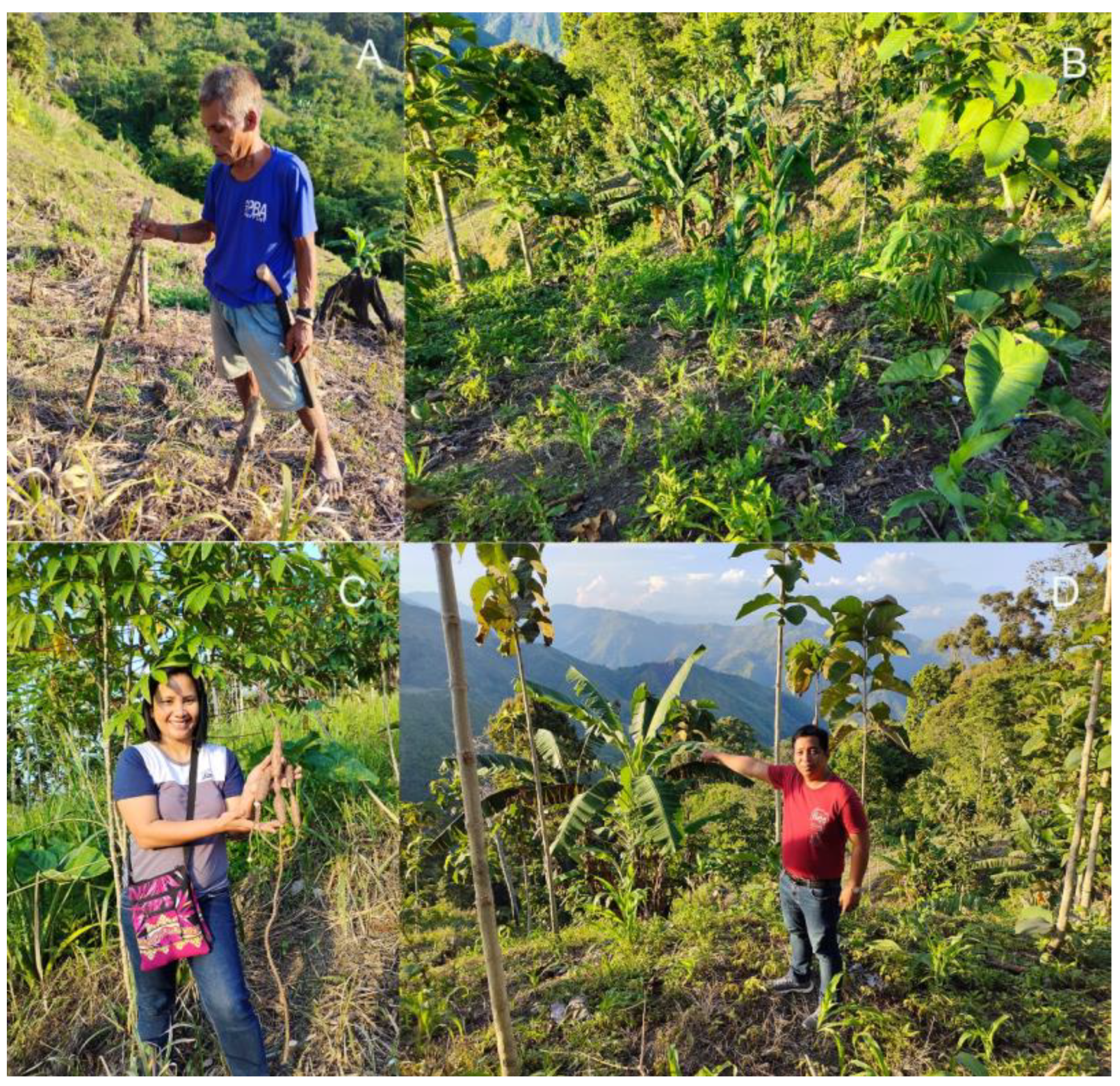
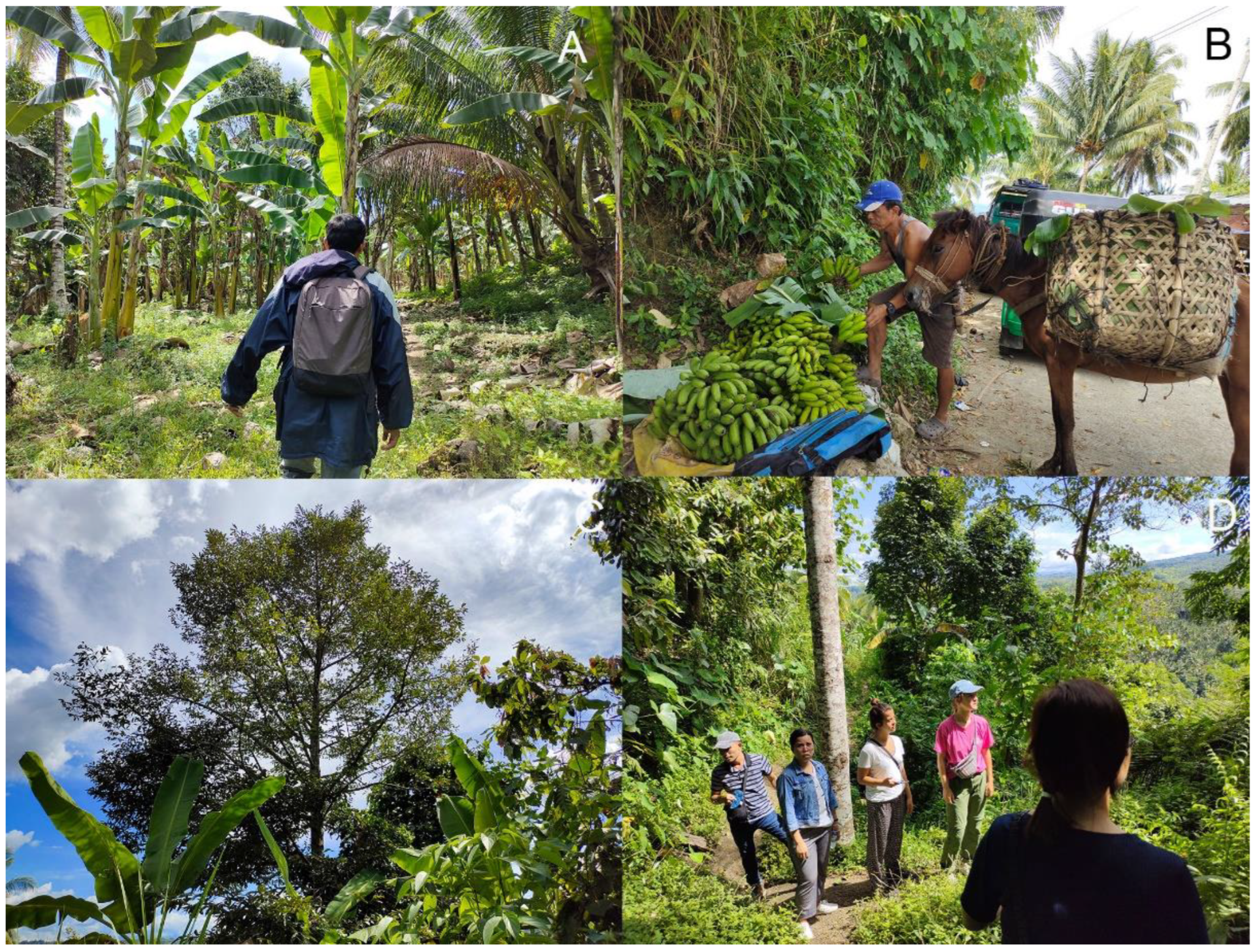
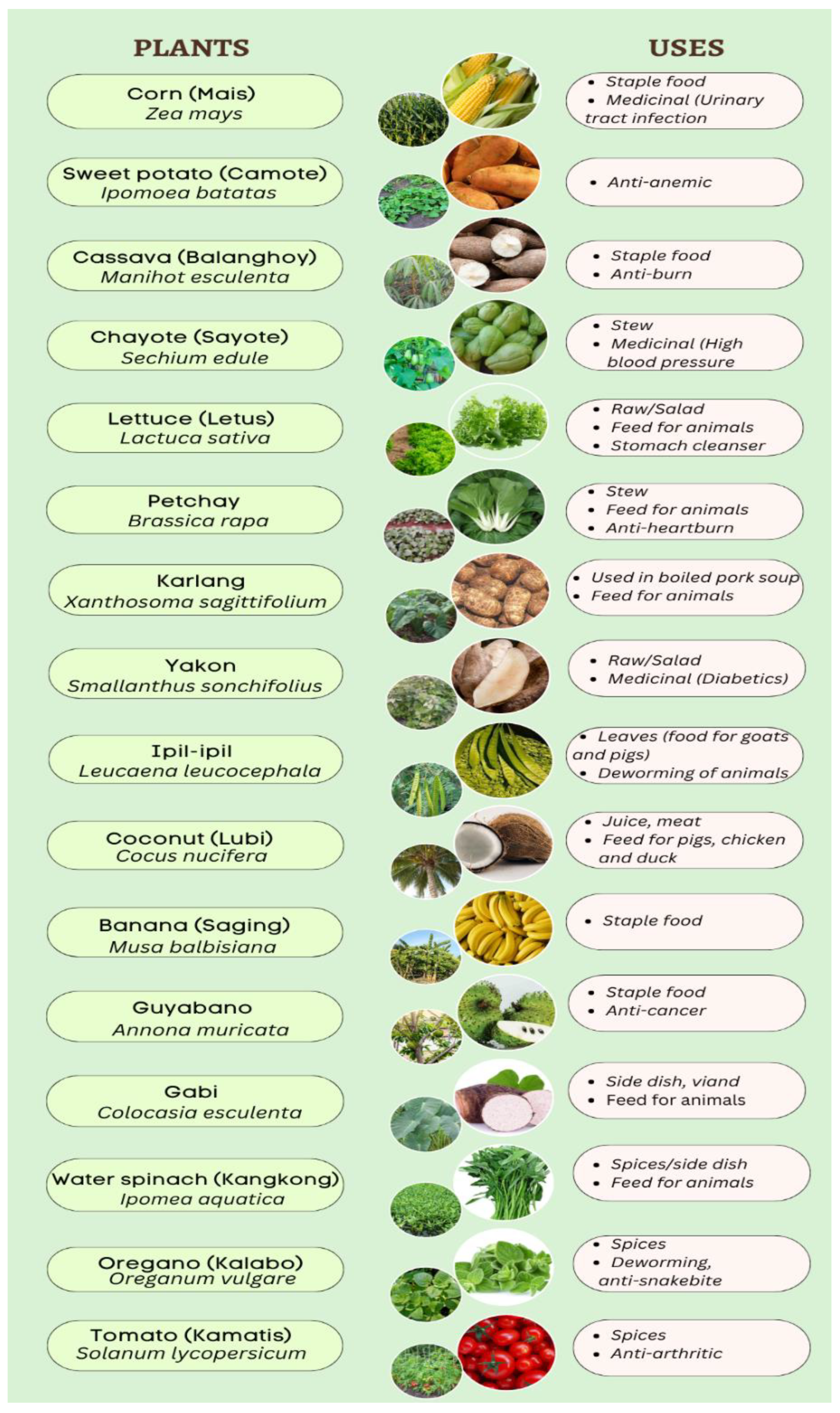
| Livelihood | Resources | Skills Present | Remarks/Suggestions |
|---|---|---|---|
| Livelihood present in the area | |||
| Vegetable farming | Cold and warm season crops | yes | Need for fertilizers for vegetable farming, seeds for varieties planted, knapsack sprayer, tools |
| Corn farming | Sige-sige (yellow ug puti nga mais) | yes | |
| Rice farming | Dinurado, pilit, asuzena | yes | |
| Abaca farming | Native variety available | Need to plant the tanggungon variety because the native variety of abaca cannot be sold | |
| Bead making | yes | Materials for bead making | |
| Banana farming | cardaba, tundan, binangay | yes | Need for market connections |
| Livelihood aspired for | |||
| Inland fisheries | Tilapia, Catfish | Very interested | Training on backyard pond raising and nets/and feed-making apparatuses for backyard ponds |
| Ornamental plants | Seeds, cuttings, plants available | Very interested | Training on propagation |
| Tribal dressmaking | Skilled women and stalls are available but without materials e.g., singer and electric sewing machines | The women’s group was very interested | Sewing machines are needed (manual and electric); fabric/clothing materials are also needed |
| Livestock | Carabao, horses | Very interested | Livestock giveaways |
| Livelihood | Resources | Skills | Remarks/Suggestions |
|---|---|---|---|
| Livelihood present in the area | |||
| 1. Brgy. Panyalum (Farming) Fruit plantations | Banana, durian, lansones, breadfruit, rambutan, coconut farms, abaca farms | Traditional way | Cycle of tending to harvesting takes a long time; cheap farm gate prices |
| Livestock raising | Goats, native pigs, poultry | ||
| 2. Brgy. Mapula (Farming) | Abaca, cacao, banana, corn, coconut, peanut, Durian, coffee (robusta) | Traditional and modern farming methods (uses fertilizer) | |
| Livestock raising | native pigs, poultry | yes, present | |
| 3. Brgy. Callayawan (Farming) | Banana (cardava, tundan), coffee, breadfruit, coconut, lansones | yes, present | |
| Livestock raising | Goats, ducks | Yes, present | |
| 4. Brgy. Malabog (Farming) | Sweet potato farming, corn farming, squash farming, chayote (sayote), ube (karlang) | Modernized farming using fertilizers and pesticides | |
| 5. Brgy. Salapawan (Farming) | Abaca, banana, cacao, coconut, corn | Yes, present | Abaca buyers stopped buying variety and farm gate prices of coconut copras are cheap |
| Livestock raising | Layer chicken | Yes, present | Feeds and vitamins are expensive |
| Traditional dresses (women) | Traditional and cultural | Yes, present | |
| Livelihood aspirations | |||
| 1. Farming of durian, rambutan, mangoesteen | yes | Sufficient seedlings of durian, and mangoesteen for planting | |
| 2. Farming of vegetables, corn | Squash, corn | yes | Training on squash farming and market connections; seed materials of corn and fertilizers |
| 3. Raising native chicken | Heads of free-range native chicken in addition to their layer chicken | ||
| 4. Traditional dressmaking | Traditional and cultural | yes | Sewing machines are needed (manual and electric); fabric/clothing materials are also needed |
| 5. Inland lake floating cages | Tilapia/catfish | yes | Nets, drums, bamboo, and feed development for Tilapia and livestock |
| 6. Coconut oil processing | Coconuts are available | yes | Pilot oil processing plant |
| 7. Feed processing | Raw materials are available | Training on feed formulation using indigenous resources | |
Disclaimer/Publisher’s Note: The statements, opinions and data contained in all publications are solely those of the individual author(s) and contributor(s) and not of MDPI and/or the editor(s). MDPI and/or the editor(s) disclaim responsibility for any injury to people or property resulting from any ideas, methods, instructions or products referred to in the content. |
© 2023 by the authors. Licensee MDPI, Basel, Switzerland. This article is an open access article distributed under the terms and conditions of the Creative Commons Attribution (CC BY) license (https://creativecommons.org/licenses/by/4.0/).
Share and Cite
Macusi, E.S.; Sales, A.C.; Macusi, E.D.; Bongas, H.P.; Cayacay, M.A.; Omandam, J.L.; Schüler, M.; Vidal, C. Indigenous Knowledge Systems and Practices (IKSPs), Livelihood Resources and Aspirations of the Matigsalog and Ata Tribes. Sustainability 2023, 15, 11182. https://doi.org/10.3390/su151411182
Macusi ES, Sales AC, Macusi ED, Bongas HP, Cayacay MA, Omandam JL, Schüler M, Vidal C. Indigenous Knowledge Systems and Practices (IKSPs), Livelihood Resources and Aspirations of the Matigsalog and Ata Tribes. Sustainability. 2023; 15(14):11182. https://doi.org/10.3390/su151411182
Chicago/Turabian StyleMacusi, Erna S., Anthony C. Sales, Edison D. Macusi, Henzel P. Bongas, Melanie A. Cayacay, Juber L. Omandam, Marthje Schüler, and Camila Vidal. 2023. "Indigenous Knowledge Systems and Practices (IKSPs), Livelihood Resources and Aspirations of the Matigsalog and Ata Tribes" Sustainability 15, no. 14: 11182. https://doi.org/10.3390/su151411182
APA StyleMacusi, E. S., Sales, A. C., Macusi, E. D., Bongas, H. P., Cayacay, M. A., Omandam, J. L., Schüler, M., & Vidal, C. (2023). Indigenous Knowledge Systems and Practices (IKSPs), Livelihood Resources and Aspirations of the Matigsalog and Ata Tribes. Sustainability, 15(14), 11182. https://doi.org/10.3390/su151411182








